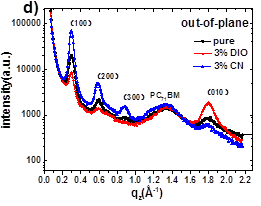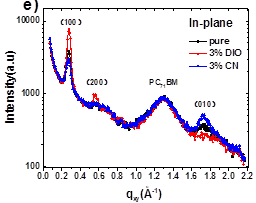| Revealing the Effect of Additives with Different Solubility on the Morphology and the Donor Crystalline Structures of Organic Solar Cells |
| From: PublishDate:2017-06-16 Hits: |
The microstructure of the active layer of the heterojunction organic solar cells has an important effect on the performance of the device. To date, a variety of optimization methods can control the microstructure of the active layer, solvent additive method is simple convenient and can greatly enhance photovoltaic performance which is a significant morphological control method. However, the mechanism of action of this effective micro-regulation method is still not explained. Suling Zhao team of Institute of Optoelectronic Technology, Beijing Jiaotong University studied the mechanism of the solvent additive detailly. The research results were published in ACS Application Materials & Interfaces on June 22, 2016. Their team found that there was a difference in the interaction between different types of solvent additives such as 1,8-octanedithiol (ODT), 1,8-diiodooctane (DIO), diphenylether (DPE), 1-chloronaphthalene (CN) and polymer molecules. The performance of BHJ PSCs processed by the additive (CN) dissolving both donor and acceptor molecules was enhanced more than that of BHJ PSCs processed by the additive (DIO) dissolving only acceptor molecules. The prepared BHJ PSCs with CN treated had a high Jsc, FF, and PCE up to 17.752 mA/cm2, 73.1%, and 10.25%, respectively. The improvement of PCE came from the meliorative thick-film nanoscale morphology and molecular orientation of active layer, which in return facilitate charge transport within the active layer.
The molecular structure of the active layer films under different treatment conditions was studied by using the GIWAXS and GIXRD modes of the Beijing Synchrotron Radiation Facility (BSRF) 1W1A diffuse station. It was found that the two additives of DIO and CN had different guiding effects on the accumulation orientation of polymer in the process of film formation. DIO would direct the polymer molecules to crystallize along the π-π bond (010) parallel to the substrate of the face-on direction, while the CN leaded the polymer to crystallize along the alkyl chain (h00). And the law of tacking crystallization perpendicular to the substrate of the edge-on direction was opposite to the face-on direction. The synchrotron radiation source is a powerful way to detect the regularity of the polymer crystal accumulation in the direction of accumulation of polymer, which makes it possible to further understand the mechanism of the additive improve morphology of the heterogeneous organic solar cell. Article: Jiao Zhao, Suling Zhao,* Zheng Xu, Bo Qiao, Di Huang, Ling Zhao, Yang Li, Youqin Zhu, and Peng Wang. Revealing the Effect of Additives with Different Solubility on the Morphology and the Donor Crystalline Structures of Organic Solar Cells. ACS Applied Materials & Interfaces 8(28): 18231-18237. |
|
|
| Chinese
- Metal-free efficient photocatalyst for stable visible water splitting——Top ten major scientific progresses in China in 2015
- The nano-resolution imaging platform was awarded the first rate prize of Beijing Science and Technology in 2014
- Beamline 1W1 of BSRF started to runoperate in the couplingparasitic mode of BEPCII
- Synthesis of High Performance Polymer Materials for Field Effect-Transistors
- Surfactant molecular aggregates in green solvents
- GIXRD has played an important role in the characterization of organic thin-film transistors
Science Highlights
Home /
Copyright © 2011 - 2012 Beijing Synchrotron Radiation Facility




